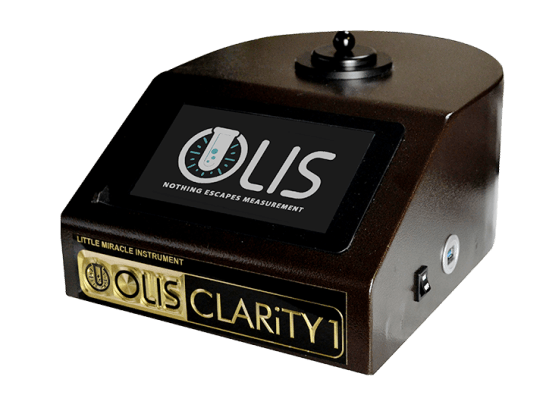Top Guidelines Of Spectrophotometers
Top Guidelines Of Spectrophotometers
Blog Article
The Main Principles Of Circular Dichroism
Table of ContentsSome Ideas on Spectrophotometers You Need To KnowUv/vis/nir Can Be Fun For AnyoneFascination About Circular DichroismThe 25-Second Trick For Uv/visIndicators on Circular Dichroism You Need To Know

Although spectrophotometry is most typically used to ultraviolet, visible, and infrared radiation, modern-day spectrophotometers can interrogate large swaths of the electro-magnetic spectrum, including x-ray, ultraviolet, visible, infrared, and/or microwave wavelengths. Spectrophotometry is a tool that depends upon the quantitative analysis of molecules depending on how much light is soaked up by colored compounds.
Not known Details About Uv/vis
A spectrophotometer is commonly utilized for the measurement of transmittance or reflectance of solutions, transparent or nontransparent solids, such as refined glass, or gases. Although lots of biochemicals are colored, as in, they soak up noticeable light and therefore can be measured by colorimetric treatments, even colorless biochemicals can frequently be converted to colored compounds ideal for chromogenic color-forming reactions to yield compounds appropriate for colorimetric analysis.: 65 Nevertheless, they can likewise be created to measure the diffusivity on any of the listed light ranges that normally cover around 2002500 nm utilizing different controls and calibrations.
An example of an experiment in which spectrophotometry is utilized is the determination of the equilibrium constant of a solution. A particular chain reaction within a solution may take place in a forward and reverse instructions, where reactants form products and products break down into reactants. At some point, this chemical reaction will reach a point of balance called a stability point.
Our Circularly Polarized Luminescence Ideas
The quantity of light that travels through the solution is indicative of the concentration of particular chemicals that do not allow light to go through. The absorption of light is due to the interaction of light with the electronic and vibrational modes of particles. Each kind of molecule has a specific set of energy levels related to the makeup of its chemical bonds and nuclei and therefore will soak up light of specific wavelengths, or energies, resulting in unique spectral residential or commercial properties.
Making use of spectrophotometers covers different scientific fields, such as physics, materials science, chemistry, biochemistry. UV/Vis/NIR, chemical engineering, and molecular biology. They are commonly utilized in numerous markets consisting of semiconductors, laser and optical manufacturing, printing and forensic assessment, as well as in labs for the study of chemical substances. Spectrophotometry is frequently used in measurements of enzyme activities, decisions of protein concentrations, determinations of enzymatic kinetic constants, and measurements of ligand binding reactions.: 65 Eventually, a spectrophotometer has the ability to identify, depending on the control or calibration, what substances exist in a target and precisely just how much through estimations of observed wavelengths.
Created by Arnold O. Beckman in 1940 [], the spectrophotometer was produced with the help of his associates at his company National Technical Laboratories established in 1935 which would become Beckman Instrument Company and ultimately Beckman Coulter. This would come as a solution to the previously produced spectrophotometers which were unable to soak up the ultraviolet correctly.
Examine This Report about Circularly Polarized Luminescence
It would be found that this did not offer acceptable outcomes, therefore in Design B, there was a shift from a glass to a quartz prism which allowed for much better absorbance outcomes - UV/Vis (https://soundcloud.com/julieanndesalorenz30606). From there, Design C was born with an adjustment to the wavelength resolution which wound up having three systems of it produced
It irradiates the sample with polychromatic light which the sample takes in depending upon its residential or commercial properties. Then it is sent back by grating the photodiode selection which finds the wavelength area of the spectrum. Ever since, the production and implementation of spectrophotometry devices has actually increased exceptionally and has ended up being one of the most ingenious instruments of our time.

Rumored Buzz on Uv/vis/nir
Historically, spectrophotometers use a monochromator including a diffraction grating to produce the analytical spectrum. The grating can either be movable or fixed. If a single detector, such as a photomultiplier tube or photodiode is utilized, the grating can be scanned stepwise (scanning spectrophotometer) so that the detector can determine the light intensity at each wavelength (which will represent each "action").
In such systems, the grating is fixed and the strength of each wavelength of light is measured by a various detector in the selection. Furthermore, most modern-day mid-infrared spectrophotometers utilize a Fourier transform method to obtain the spectral information - https://www.livebinders.com/b/3570027?tabid=514355ed-03f4-acee-f8e7-d79f6b7bffab. This method is called Fourier transform infrared spectroscopy. When making transmission measurements, the spectrophotometer quantitatively compares the fraction of light that travels through a referral service and a test option, then electronically compares the intensities of the 2 signals and calculates the portion of transmission of the sample compared to the referral requirement.

Report this page